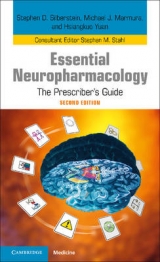
Essential Neuropharmacology
Cambridge University Press (Verlag)
978-0-521-13672-3 (ISBN)
- Titel erscheint in neuer Auflage
- Artikel merken
Essential Neuropharmacology: The Prescriber's Guide expertly reviews the most important medications used by neurologists in their practice. Experienced clinicians share their expert knowledge about the best use of medications in patient care. Each drug listing contains the range of indications, their advantages and disadvantages, and tips for dosing and avoiding adverse effects. Experts in fields such as multiple sclerosis, movement disorders, neuromuscular disorders, epilepsy, stroke, pain and headache summarize how neurologists use these medications to their best effect, and discuss off-label uses in neurology. Evidence is taken from recent clinical trials, which helps the reader relate the content to everyday clinical practice. The detailed descriptions of each medication enable the user to make quick and informed decisions with the confidence they need to best serve the clinical needs of their patients. This book is an essential, user-friendly reference suitable for all neurologists at all stages of their careers.
Stephen D. Silberstein is Professor, Jefferson Medical College, Thomas Jefferson University and Director, Jefferson Headache Center, Thomas Jefferson University Hospital, Philadelphia, USA. Michael J. Marmura is Assistant Professor, Department of Neurology, Jefferson Headache Center, Thomas Jefferson University Hospital, Philadelphia, USA.
Introduction; List of icons; Acetozolamide; Almotriptan; Amantadine; Apomorphine; Armodafinil; Azathioprine; Baclofen; Benztropine; Botulinum Toxin A; Botulinum Toxin B; Bromocriptine; Carbamezapine; Carbidopa/Levidopa; Carisoprodol; Chlorpromazine; Clonazepam; Clonidine; Clozapine; Crypohepatidine; Cyclobenzaprine; Cyclophosphamide; Cyclosporine; Dantrolene; Diazepam; 3-4 Diaminopyrimidine; Dihydroergotamine; Donepezil; Droperidol; Edrophonium; Eletriptan; Entacapone; Ethosuximide; Felbamate; Flunarazine; Frovatriptan; Gabapentin; Galantamine; Glatiramer; Guanfacine; Guanidine Hydrochloride; Haloperidol; Indomethacin; Interferon B; IVIG; Lacosemide; Lamotrigine; Levitiracetam; Lithium; Memantine; Metaclopramide; Metaxalone; Methocarbamol; Methotrexate; Methylergovonine; Methysergide; Mexiletine; Mitoxantrone; Modafinil; Mycophenolate; Naratriptan; Natalizumab; Oxcarbazepine; Parmipexole; Penicillamine; Phenobarbital; Phenytoin; Pizotofen; Prednisone; Pregabalin; Primidone; Prochlorperazine; Propranolol; Pyridostigmine; Quetiapine; Quinine; Rasagiline; Reserpine; Riluzole; Rituximab; Rivastigmine; Rizatriptan; Ropinirole; Rufinamide; Selegiline; Sumatriptan; Tetrabenazine; Tiagabine; Timolol; Tizanadine; Topirimate; Trientine; Trihexyphenidil; Valproic Acid; Verapamil; Vigabatrin; Zolmotriptan; Zonisamide; Index by drug name; Index by use; Index by class; Abbreviations.
| Erscheint lt. Verlag | 22.7.2010 |
|---|---|
| Reihe/Serie | Cambridge Medicine |
| Illustrationen | Nancy Muntner |
| Mitarbeit |
Berater: Stephen M. Stahl |
| Verlagsort | Cambridge |
| Sprache | englisch |
| Maße | 142 x 228 mm |
| Gewicht | 620 g |
| Themenwelt | Medizin / Pharmazie ► Medizinische Fachgebiete ► Neurologie |
| Medizin / Pharmazie ► Medizinische Fachgebiete ► Pharmakologie / Pharmakotherapie | |
| Medizin / Pharmazie ► Pharmazie | |
| Schlagworte | Neuropharmakologie |
| ISBN-10 | 0-521-13672-5 / 0521136725 |
| ISBN-13 | 978-0-521-13672-3 / 9780521136723 |
| Zustand | Neuware |
| Haben Sie eine Frage zum Produkt? |
aus dem Bereich



